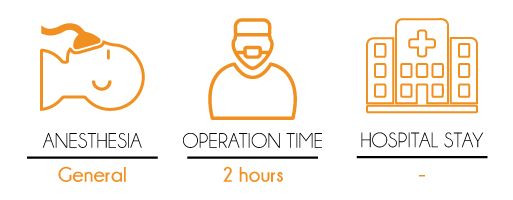
Fill out the form and we’ll call you!

Rhinoplasty, sometimes called the “nose job”, is an operation performed to remodel and correct the shape of the nose.
The nose is in the centre of the face but does not have to be the centre of attention. Your nose has to be in harmony with the other parts of your face. For this reason, the ideal nose may vary depending on the person.
With Rhinoplasty :
– The tip of the nose can be reduced or it can be lifted.
– Nose tip can be reduced to a normal level.
– Nostrils can be narrowed or enlarged.
– If the nose is too long, it can be shortened, if it is too short, it can be extended.
– If there is an axle misalignment in the nose, it can be corrected.
– If there is are visible humps in the nose profile or depressions on the bridge can be treated.
– Cartilage can be added or removed according to breathing problems.
– Complaints such as inability to breathe, snoring and sinusitis due to deviation can be treated.
– When you look in the mirror, if your nose is asymmetrical, bulky or has humps or depressions, you can have rhinoplasty if you feel uncomfortable with this situation.
– Both men and women can have this surgery. Especially in recent years, rhinoplasty is among the aesthetic operations frequently performed by men.
– Rhinoplasty can be performed from the age of 16-17 for women and 17-18 for men.
– First of all, you should clearly explain your aesthetic concerns and expectations from this surgery. Consulting with your doctor about your expectations and wishes regarding this surgery will increase your satisfaction afterwards.
– If you have regular medications, consult your doctor.
– If you smoke, you must quit at least 10 days before surgery. Because smoking makes it difficult to heal postoperative tissues and stitch scars.
– If you are taking medications such as blood thinners and aspirin, consult your doctor. You will be asked not to use these medications for a while.
There are two methods in rhinoplasty surgery:
– Open Rhinoplasty
– Closed Rhinoplasty
If you are going to have revision surgery on your nose, it is recommended to perform an open rhinoplasty. In open rhinoplasty, the nose structure can be examined more clearly.
In closed rhinoplasty surgery, there are no stitches at the tip of the nose as in open surgery, and the stitches are thrown into the nose. Some swelling may be seen after the operation. However, bruises do not occur as in open surgery. Recovery will be faster.
Which of these surgical techniques can be applied is decided by the doctor’s physical examination by examining your nasal structure and the patient is informed about this.
– On the day of the surgery, you will have to eat soft food. In the following days, you can return to your normal diet.
– You will need to drink plenty of fluids so that your mouth is not dry.
– The first week you will have to sleep on two pillows to keep your head straight.
– Use pain killers and aspirin prescribed by your doctor.
– The first day after the procedure you can shower with a slicked-back hairstyle to prevent your nose from getting wet in the shower.
-The first few days you may have a small nosebleed. Do not panic this is normal.
– Between 2 or 3 days after the surgery, bruises may appear around the eyes. These bruises will disappear in 2 weeks.
– The doctor will remove the plugs from your nose in 2 to 4 days.
– After removing the plugs from your nose, you will be advised to clean the inside of your nose with an ear swab and water.
– Stitches that used in rhinoplasty will dissolve.
– Especially in the first months, you should avoid getting hits in your nose.
– 1 week rest is recommended after the operation. Then, by consulting your doctor, you can go to work and continue your normal life as long as working conditions are not severe.
– You should stay away from heavy exercise for 2-3 weeks.
– You should use the nasal spray and creams given by your doctor regularly.
– You should not wear glasses, including sunglasses, for the first 3 months.
– You should protect your nose from sunlight and use sunscreen.
– You should not smoke as it affects wound healing negatively.
– While most of the post-operative edema heals within 1 week, the nose takes its full shape in 1 year.
 English
English  Turkish
Turkish  German
German  Spanish
Spanish 